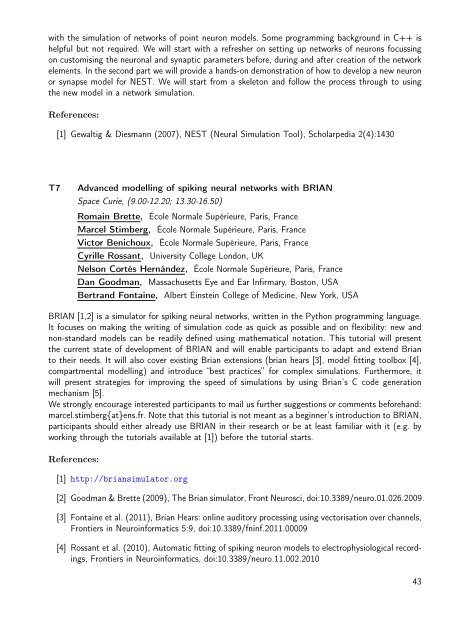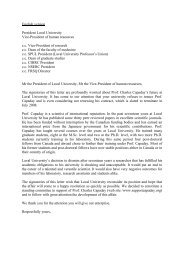Untitled - Laboratory of Neurophysics and Physiology
Untitled - Laboratory of Neurophysics and Physiology
Untitled - Laboratory of Neurophysics and Physiology
Create successful ePaper yourself
Turn your PDF publications into a flip-book with our unique Google optimized e-Paper software.
with the simulation <strong>of</strong> networks <strong>of</strong> point neuron models. Some programming background in C++ is<br />
helpful but not required. We will start with a refresher on setting up networks <strong>of</strong> neurons focussing<br />
on customising the neuronal <strong>and</strong> synaptic parameters before, during <strong>and</strong> after creation <strong>of</strong> the network<br />
elements. In the second part we will provide a h<strong>and</strong>s-on demonstration <strong>of</strong> how to develop a new neuron<br />
or synapse model for NEST. We will start from a skeleton <strong>and</strong> follow the process through to using<br />
the new model in a network simulation.<br />
References:<br />
[1] Gewaltig & Diesmann (2007), NEST (Neural Simulation Tool), Scholarpedia 2(4):1430<br />
T7<br />
Advanced modelling <strong>of</strong> spiking neural networks with BRIAN<br />
Space Curie, (9.00-12.20; 13.30-16.50)<br />
Romain Brette, École Normale Supérieure, Paris, France<br />
Marcel Stimberg, École Normale Supérieure, Paris, France<br />
Victor Benichoux, École Normale Supérieure, Paris, France<br />
Cyrille Rossant, University College London, UK<br />
Nelson Cortés Hernández, École Normale Supérieure, Paris, France<br />
Dan Goodman, Massachusetts Eye <strong>and</strong> Ear Infirmary, Boston, USA<br />
Bertr<strong>and</strong> Fontaine, Albert Einstein College <strong>of</strong> Medicine, New York, USA<br />
BRIAN [1,2] is a simulator for spiking neural networks, written in the Python programming language.<br />
It focuses on making the writing <strong>of</strong> simulation code as quick as possible <strong>and</strong> on flexibility: new <strong>and</strong><br />
non-st<strong>and</strong>ard models can be readily defined using mathematical notation. This tutorial will present<br />
the current state <strong>of</strong> development <strong>of</strong> BRIAN <strong>and</strong> will enable participants to adapt <strong>and</strong> extend Brian<br />
to their needs. It will also cover existing Brian extensions (brian hears [3], model fitting toolbox [4],<br />
compartmental modelling) <strong>and</strong> introduce “best practices” for complex simulations. Furthermore, it<br />
will present strategies for improving the speed <strong>of</strong> simulations by using Brian’s C code generation<br />
mechanism [5].<br />
We strongly encourage interested participants to mail us further suggestions or comments beforeh<strong>and</strong>:<br />
marcel.stimberg{at}ens.fr. Note that this tutorial is not meant as a beginner’s introduction to BRIAN,<br />
participants should either already use BRIAN in their research or be at least familiar with it (e.g. by<br />
working through the tutorials available at [1]) before the tutorial starts.<br />
References:<br />
[1] http://briansimulator.org<br />
[2] Goodman & Brette (2009), The Brian simulator, Front Neurosci, doi:10.3389/neuro.01.026.2009.<br />
[3] Fontaine et al. (2011), Brian Hears: online auditory processing using vectorisation over channels,<br />
Frontiers in Neuroinformatics 5:9, doi:10.3389/fninf.2011.00009<br />
[4] Rossant et al. (2010), Automatic fitting <strong>of</strong> spiking neuron models to electrophysiological recordings,<br />
Frontiers in Neuroinformatics, doi:10.3389/neuro.11.002.2010<br />
43



